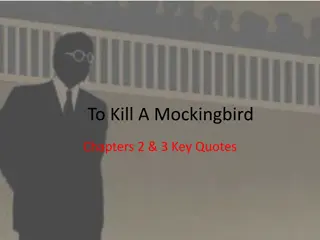Analyzing Themes and Characters in Harper Lee's To Kill a Mockingbird
Explore the characteristics of Southern women, character growth of Scout and Jim, Atticus' relationship with his children, themes of racism and loss of innocence, and the concept of absent characters in Harper Lee's iconic novel. Delve into the social structure of the early 1900s South, the impact of social class on attitudes, and Lee's use of literary techniques. Uncover insights about Lee's personal life and the influences behind her characters.
Download Presentation

Please find below an Image/Link to download the presentation.
The content on the website is provided AS IS for your information and personal use only. It may not be sold, licensed, or shared on other websites without obtaining consent from the author.If you encounter any issues during the download, it is possible that the publisher has removed the file from their server.
You are allowed to download the files provided on this website for personal or commercial use, subject to the condition that they are used lawfully. All files are the property of their respective owners.
The content on the website is provided AS IS for your information and personal use only. It may not be sold, licensed, or shared on other websites without obtaining consent from the author.
E N D
Presentation Transcript
Unit Objectives Identify the characteristics of the Southern Woman in the early twentieth century Analyze character growth exhibited by both Scout & Jim Discuss the relationship of Atticus with his children Explain Harper Lee s themes of racism, loss of innocence and deceptive appearances Explain the concept of the absent character
Unit Objectives Cont. Analyze Atticus's character and what he represents Describe the impact of social class on characters attitudes and actions Explain Lee s use of humor, suspense, and allusions as literary techniques Identify an define the literary devices that Lee uses such as similes, metaphors, and idioms
Meet the Author Harper Lee modeled the character of Scout after herself. She was born in Monroeville, AL in 1926. Lee s father was also a small town lawyer. The Scottsboro Boys In April 1931, in Scottsboro, AL, nine African-American men were tried for raping two white women. The all-white jury convicted the men and sentenced them to death. Harper was 6 years old and had an impact on her.
Famous Childhood Friend Lee s close childhood friend was the famous author Truman Capote. They spent summers playing together. Capote was the model for Lee s character, Dill in To Kill a Mockingbird.
Southern Social Structure of the Early 1900 s Upper Class doctors, lawyers, plantation owners, and business professionals Middle Class small farmers, and small-town business owners Lower Class African-American farmers and unskilled laborers, such as mill workers The Great Depression 1930 s Between 1929-1932, farm prices fell over 50%, and the average income in 1929 was $750, but farm income was $275.
Sharecroppers & Landowners The white people owned acres of land but had very little cash. African American farmers worked as sharecroppers. The landowner divided land into shares and provided small houses, tools, and seeds. Some also fed, clothed, and provided medical care for the sharecropper families. The landowners received a part of the profits.
Southern Heritage The Appearance of money of comfort was more important than the the lack of it. Lack of money could not be the differentiating factor The use of Southern ancestry as a differentiating factor
Racism in the South Most significant issue of the South during the 1930 s was segregation. Subtle interpretations of laws helped to keep African-Americans immersed in poverty. Mill jobs were reserved for whites Rules for lending money favored suburban areas Southern States circumvented the Fifteenth Amendment Stringent voter registrations requirements such as literacy tests and poll taxes
Racism in the South Consequence for testing authority - LYNCHING Murderers would not even stand trial for this crime. Tar and feathering Hanging from a tree until dead The Ku Klux Klan (KKK) was founded by the Confederate army vets to oppose changes that occurred during Reconstruction. KKK used lynching as a means of intimidation.
The Scottsboro Boys In 1931, five African-American teenage boys were falsely accused of raping two white girls on a train from Chattanooga to Memphis. The teens were sentenced to terms ranging from 75 to 99 years in prison with several receiving the death penalty. The US Supreme Court overturned the verdicts twice. Once because the defendants were given inadequate counsel The grand juries did not have any African-Americans on them The youths were retried in Alabama. One woman recanted. The boys were found guilty. The state finally dropped the charges in 1937.
Civil Rights Movement TKAM was published in 1960 and was a bestseller for over a year and a half. The 1960 s was a time of turbulent civil protest in the this country. Alabama was a predominantly segregated state. 1954 Brown vs. Board of Ed. 1955 Rosa Parks & the Montgomery Bus Boycott 1956 first African-American woman admitted to University of Alabama
Civil Rights Movement Harper Lee won the Pulitzer Prize in 1961 . Over 15 million copies of the book were sold in the early years Critics hail TKAM as an accurate portrayal of racist discrimination in the South. Considered quite controversial in school settings























